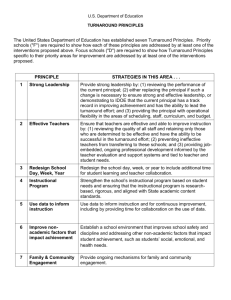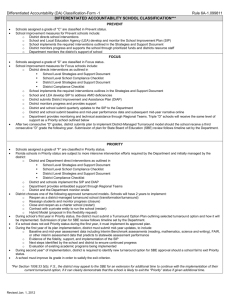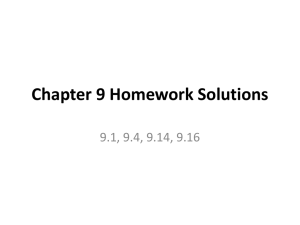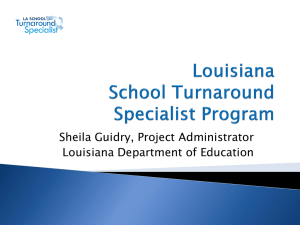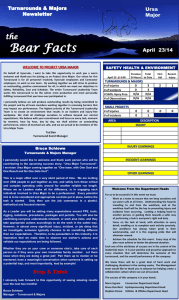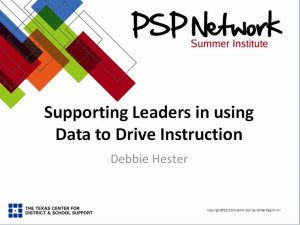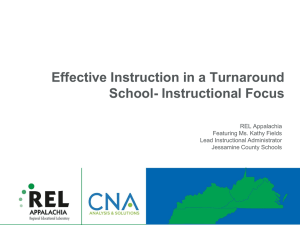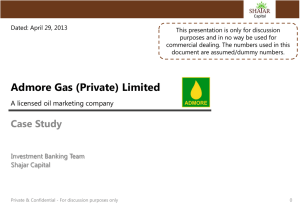Priority-Focus Webinar - Comprehensive Planning
advertisement
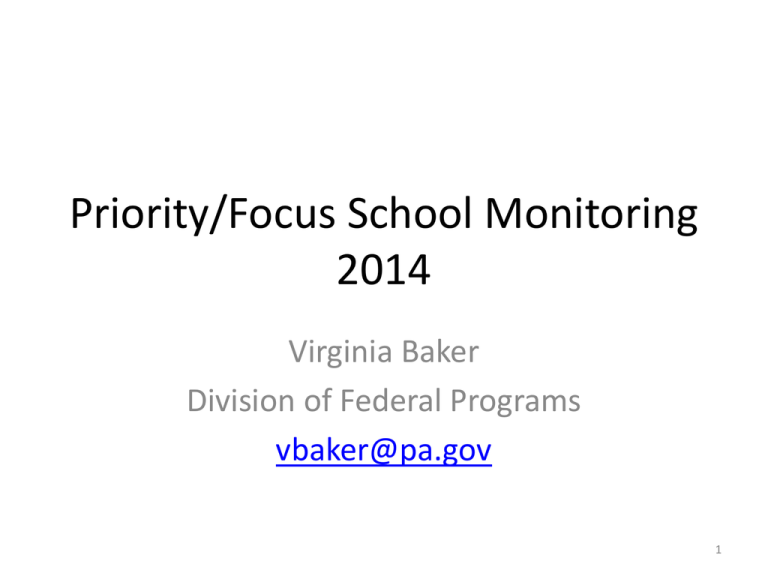
Priority/Focus School Monitoring 2014 Virginia Baker Division of Federal Programs vbaker@pa.gov 1 How did you get here? • Priority schools – Lowest 5 % of Title I schools – Based on aggregate math and reading proficiency, or – Algebra I/Literature Keystone exams, or – Title I school receiving SIG (School Improvement Grant) funds • Focus schools – Lowest 10% of Title I schools – Based on highest achievement gap for Historically Low Performing students, or – Title I school with a graduation rate below 60%, or – Test participation rate below 95%, AND – Not a Priority school 2 Monitoring Generalities • All Priority schools will be monitored this year • Half of the Focus schools will be monitored this year; other half will be monitored in 2014-15 school year • Monitors have been assigned. Training will take place March 4 & 5 • Academic Recovery Liaisons will be assigned to Priority schools to help with planning interventions • Title I-A, Title II-A and Title III (if applicable) will be monitored at the same time 3 Timeline • Letters will go out to superintendents the week of March 17 – Name of Monitor – Login/Password for Fed Monitor system • Monitor will contact the district to set up date(s) for monitoring • May be a team of monitors depending on the number of buildings 4 Timeline • 2 weeks prior to visit – district personnel access Fed Monitor and fill out online monitoring instruments – Title I, II and III – Priority/Focus school monitoring instrument • Monitor(s) will review monitoring instruments prior to visit and verify documentation 5 Timeline • After monitoring visit, monitors will make any changes/additions to instrument that are warranted and lock the instrument • Schools have 3 years to complete all the required elements for Priority/Focus interventions 6 What documentation should be available to the Monitors? • Comprehensive Plan – School Level • Leadership Team membership – LEA Level – School Level • Include parents on the teams • Schedule of Leadership Team meetings • ARL may be available for monitoring visit to discuss direction of district 7 Monitoring Visits will include: – Review of documentation – Observation of interventions – Interviews of appropriate staff • ARL, if available • Principal • Other members of the leadership team 8 Priority/Focus Schools • Schools must choose interventions to assist in meeting the four Annual Measurable Objectives (AMOs) – Test Participation Rate – 95% participation on PSSA/Keystones – Graduation rates (85%)/Attendance rates if no graduation rate) (90% or improvement from previous year) – Closing Achievement Gap – All Students – Closing Achievement Gap – Historically Underperforming Students 9 Exiting Priority Status • Make all 4 AMOs for 3 consecutive years • If not, significant changes aligned with the one of the 4 SIG options will be required 10 Exiting Focus status • Make all 4 AMOs for 3 consecutive years • If not, implement a revised improvement plan with additional supports • Focus schools that have not exited Focus status after an additional 3 years will be designated Priority schools 11 Choosing Interventions • Characteristics of high performing schools: – – – – – – – – – Clear and shared focus High standards and expectations Effective leadership High levels of collaboration and communication Curriculum, instruction and assessment aligned to standards Frequent monitoring of teaching and learning Focused professional development Supportive learning environment High levels of community and parent involvement 12 Intervention Models • School Improvement Grant model – School Closure – School Restart – School Turnaround – School Transformation • Model aligned with 7 Turnaround Principles – Priority schools must adopt all 7 principles – Focus schools must adopt at least one principle 13 Additional interventions • Tiered interventions – Set of interventions strategically designed to address the range of student needs within a school (RTII) • Needs analysis that leads to interventions ties to a specific subgroup needs 14 SIG Models • Closure – School is closed and students are sent elsewhere • Restart – School turned over to a Charter Management Organization (CMO) or an Education Management Organization (EMO) 15 SIG Model - Turnaround • • • • • • • • Replace the principal and grant flexibility Screen all staff and rehire no more than 50% Adopt a new governance structure Provide high-quality, job-embedded professional development Adopt a research-based, vertically aligned instructional program Increase learning time Provide appropriate social-emotional and community oriented services for students Include parents in planning the implementation model 16 SIG Model - Transformation • Replace principal and grant flexibility • Use a teacher evaluation system that takes into account student achievement • Identify and reward school leaders and teachers who increase student achievement and graduation rates • Remove staff who, after ample opportunities have not increased student achievement or graduation rates • Provide high-quality, job-embedded professional development • Adopt a research-based, vertically-aligned instructional program • Use student data to identify academic needs and to inform and differentiate instruction • Increase learning time • Provide ongoing mechanisms for family and community engagement 17 7 Turnaround Principles • Priority Schools must implement meaningful interventions associated with the 7 Turnaround Principles • Focus schools must implement meaningful interventions associated with at least ONE of the 7 Turnaround Principles – – – – – – – Strong leadership Effective teachers Increased learning time Strengthened instructional program Use of data to inform instruction Safe school environment Family and community engagement 18 Turnaround Principle 1 • Providing strong leadership – Review the performance of the current principal – Replace the principal Or – Demonstrate that the current principal has a track record in improving achievement and the ability to lead the turnaround effort – Provide operational flexibility in the area of staff, curriculum and budget 19 Turnaround Principle 1 – Strong Leadership • Evidence of implementation: – For principals with minimum of 3 years in current position, LEAs should provide data for: • • • • • Student achievement on Student Achievement Student attendance or graduation rates Student discipline numbers Teacher attendance rates Teacher retention rates – Flat or downward data trends signify a need to consider replacing the principal 20 Turnaround Principle 1 – Strong Leadership • Evidence of implementation: – Evidence of an LEA pipeline of turnaround leaders to support school leaders who are likely to be successful in accelerating student achievement • Partnerships with graduate schools of education • Establishment of consortia of LEAs to provide pool of leaders – Evidence of operational flexibility based on school-based data • Staggered schedule to ease transition-related student disruptions • Reallocate or repurpose staff to focus on targeted instructional needs (including participation in PA Instructional Coaching Institute) • Internal curriculum audit to ensure fidelity in the implementation of the standards • Reallocation of funds to support systematic and sustained adult learning. 21 Turnaround Principle 2 – Effective Teachers • Effective teachers – Review the quality of all staff and retain only those who are determined to be effective and have the ability to be effective – Prevent ineffective teachers from transferring into the school – Use the state Teacher Effectiveness tool based on Charlotte Danielson’s framework – Provide high-quality professional development aligned to the domains and components of the Framework for Teaching for both teachers and principals 22 Turnaround Principle 2 – Effective Teachers • Evidence of implementation – Schedule of staff reviews with: • Numbers to be evaluated each year • Numbers of teachers determined to be in need of improvement • Numbers of teachers dismissed due to unsatisfactory performance – Example of student data system used to determine how teacher effectiveness is tied to student achievement 23 Turnaround Principle 2 – Effective Teachers • Evidence of Implementation – Evidence of evaluation of implementation of teacher effectiveness system – Evidence of teachers and principals being assigned to professional development based on evaluation 24 Turnaround Principle 3 Increased Learning Time • Redesign school day, week or year to include additional time for student learning and teacher collaboration – – – – – Longer school day Add before and/or after school time Redesigned school day to increase instructional time Increase number of school days in the year Add time for teachers to collaborate on data analysis and/or instructional design – Addition of summer school for all students – Add weekend school time 25 Turnaround Principle 3 Increased Learning Time • Evidence of implementation – School calendar showing additional days added – Student schedule showing increased hours or additional student advisory periods – Teacher schedule showing addition of common planning time – Evidence of addition of full-day kindergarten or pre-kindergarten – Additional evidence of hours added for student learning or teacher collaboration 26 Turnaround Principle 4 – Strengthened Instructional Programs • Instructional program based on student needs and: – Research based – Rigorous – Aligned with PA Core Standards 27 Turnaround Principle 4 Strengthened Instructional Program • Evidence of Implementation – – – – – – – – – – – Curriculum Audit showing prioritized curriculum needs Evidence of periodic reviews of the instructional program Evidence of student progress monitoring Teacher surveys Evidence of technology-based interventions Evidence of an RTI I program Dual enrollment program Freshman academies Student transition program Credit recovery programs Early Warning systems 28 Turnaround Principle 5 Using Data to Inform Instruction • Use of a data system such as CDT to provide diagnostic information • Provide time for collaboration on the use of data • Use of an Early Warning System to improve graduation rates • Use of a reporting tool such as Kindergarten Entry Inventory to help teachers understand and track kindergarten students’ proficiency 29 Turnaround Principle 5 Using Data to Inform Instruction • Evidence of implementation – Student data system such as CDT – Teacher use of Learning Progression Maps – Use of the Kindergarten Entry Inventory – Opening Doors or other Early Warning System – Use of Schools to Watch Protocol, High Schools that Work assessments and surveys or other continuous improvement tools – Evidence of common planning time - team meeting agendas and minutes 30 Turnaround Principle 6 Safe School Environment • Establish a school environment that: – Improves safety and discipline – Addresses other non-academic factors that impact student achievement, such as students social, emotional and health needs • Establish changes in systems, protocols, procedures and culture to effect change where needed 31 Turnaround Principle 6 Safe School Environment • Evidence of Implementation – Positive School Wide Behavioral Supports – Bullying Prevention – Restorative Practices – Examination of school safety and discipline trends based on the cycle of the school year, grade/subject area, time of day, etc. 32 Turnaround Principle 7 Family and Community Engagement • Leverage the resources of the community to create learning experiences that engage youth in their communities and provide them with 21st century skills • Use digital media to interact with parents and guardians who may not be able to participate in the usual parent activities 33 Turnaround Principle 7 Family and Community Engagement • Evidence of Implementation – List of organized parent group members – Evidence of parents being involved in and informed of school turnaround decisions – Meeting agendas, notes, sign-in sheets – Community surveys – Evidence of learning experiences created with community involvement and resources – Workforce development – Evidence of the school’s effort to engage parents and community beyond traditional means, such as social media, email, blogs, website, etc – Parent education classes – Addition of a Parent Resource Center 34 State Resources • • • • • • • • • • • Academic Recovery Liaisons Standards-Aligned System (SAS) Classroom Diagnostic Tests (CDT) E-Metric PVAAS Comprehensive Planning Tool Pennsylvania Institute for Instructional Coaching (PIIC) Pennsylvania Inspired Leadership Program (PIL) Teacher Effectiveness System Principal Effectiveness System Specialist Effectiveness System 35 State Resources (cont.) • • • • • • Pennsylvania Comprehensive Literacy Plan Hybrid Learning Environment Opening Doors School Intervention funding Intermediate Unit expertise PaTTANs 36 How do we pay for it? • Title I funds – 20% of allocation must be used for interventions in Priority schools – Optional for 2013-14 • School Intervention Funds – Non-competitive – Comparable to School Improvement funds from past years • SIG Grant (School Improvement Grant) – Competitive – Up to $2 million per school per year 37 PDE Communication • Division of Federal Programs will be sending information regarding monitoring – Powerpoint – Monitoring tool – Instructions on accessing Fed Monitor • Designate a contact(s) for your LEA to receive this information and send to Kelly Iorfida at kiorfida@pa.gov – – – – LEA name and school name Name Position within the LEA Email address 38 Principle 1 – Providing Strong Leadership LEA Leadership School Leadership Requirement LEA has established a Leadership Team that meets regularly to assess the school’s improvement strategies LEA has established performance objectives for the school LEA has aligned resources with the school’s reform strategies LEA has provided ongoing, intensive technical assistance to the school Current principal’s performance has been reviewed Principal has been replaced or there is demonstration that the current principal has a track record in improving achievement and has the ability to lead the turnaround Met/Not Met/NA Suggested Evidence of Implementation List of members and meeting schedule LEA Transformation Team meeting notes Sign-in sheets Implementation Additional Year Evidence/ Comments Year 1 Year 2 Year 3 Performance objectives Evidence of progress toward objectives Year 1 Year 2 Year 3 School budget Schedule of LEA visits List of LEA supports Year 1 Year 2 Year 3 Evidence of technical assistance Year 1 Year 2 Year 3 Pennsylvania Framework for Leadership LEA has advertised for principal replacement Contract hire date Student achievement data Student discipline data Teacher attendance rates Teacher retention rates Year 1 Year 2 Year 3 Year 1 Year 2 Year 3 39 Questions??? 40
